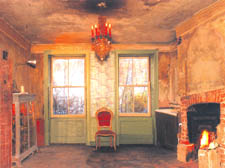|
|
 |
| |

Front room at 53 Cross Street |
Within these walls
Peter Gruner on how a punk squatter peeled back the years of his 18th-century home and helped compile a fascinating history of a north London house
FORGET your castles and palaces full of antiquities – when it comes to finding out how people really lived, you can’t beat looking over an old house.
So when art lecturer and punk squatter Martin King moved into 53 Cross Street, Islington, in 1989, he realised that this was a house full of ghosts from the past.
He began peering into the pitch black coal- strewn cellar, under filthy floorboards, and peeled away layers of dusty faded wallpaper. He discovered that the five-storey Georgian property, a stone’s throw from busy Upper Street, was built in 1785.
He thought that one day he’d love to write a book about the place.
Today, 18 years later, and thanks to collaboration with Islington historian Mary Cosh and architectural photographer Pauline Lord, his remarkable project is finally complete. 53, Cross Street: Biography of a House, is published this month with a brief history by Ms Cosh and more than 40 colourful photographs by Ms Lord.
In one room, beneath seven layers of wallpaper which had to be carefully scraped away, Martin found an original 200-year-old stencil wall painting.
Under the bedroom floorboards early in 1994 he came across a postcard dated March 13, 1897, addressed to “J Tiley Esquire.” From a visit to the Public Records office in Chancery Lane he was able to establish that Tiley was a “brass engraver and letter marker”.
Martin later met modern descendants of the family and found out that John and Elizabeth Tiley had 11 children and two lodgers and one child at least had died in the Boer war. He also discovered that there were examples of Mr Tiley’s work in St Paul’s Cathedral and Union Chapel in Canonbury.
And so the historical adventure continued. Martin, with his then housemate Mark McAuley, discovered 19th-century ink bottles, bits of brass, a 19th-century iron, and fragments of pots and clay pipes.
Behind shoddily built 1950s partition walls, they came across the original scullery containing a copper boiler. They uncovered an old fireplace, plus six dustbin bags’ worth of soot and three pigeon skeletons.
Under floorboards walnut shells were discovered. Martin was told that walnuts and watercress were an 18th century workmen’s staple diet.
One day he opened the nailed up living room shutters, closed for a hundred years and still with their 19th-century soot covered brown paint. Shining a torch through the wall cavity he found an ancient pair of stockings. Inside one was a message believed to have been written by the original builder: “George Shaw went to Aameica (America) March 1785.”
For Mary Cosh, writing her history of the house, the saddest decades were from the beginning of the 1950s when it was left in an increasingly forlorn condition.
She writes: “The floors were covered with layers of worn lino, disfigured by stiletto marks. Signs of children (who lived there) in the 60s were shown by small lost possessions – a tiny plastic coin in old currency, a tinier plastic mouse, both fallen through the floorboards of Martin’s bedroom, and a broken stiletto; while a number of film spools in the basement suggested that it might have been used as a darkroom. All of it lost or abandoned rubbish; everywhere signs of neglect.”
In 1978 Islington council compulsorily purchased the property, but were unable to afford restoration. So for the next half dozen years the house, one in a row of four, remained empty, occasionally squatted.
Then “cowboy developers” moved in, writes Mary, and converted the whole row into bed sits, by the “simple expedient of covering up old features, nailing up of shutters and boarding over the cellar walls with wood chip.”
In 1983 the council handed 53 over to the Blacksheep Housing Co-op - a bunch of “punk anarchists” who set about much needed repairs. Martin, who became a member of the co-op, moved in nine years later.
In between delving into the house’s history, and lecturing at Central St Martin’s College of Art and Design, Martin launched a campaign to give the squatters permanent tenancy. He organised impromptu tours of the house to show how the squatters had made it habitable and enlisted the help of former local MP and then Minister for Culture Chris Smith, now Lord Smith of Finsbury.
But Islington council decided to put the house up for sale in 2003. It was sold to a developer for £600,000 who sold it on to a businessman, presumably at a huge profit.
Martin said: “I was unhappy about moving out and really worried about some of the historical features I was leaving behind, particularly the stencilled wall painting.”
But fortunately the developer was of a “sensitive disposition” and as far as possible maintained the historical features.
Martin added: “The stencil was covered in protective Perspex and as far as I could see he’d made a good job of protecting the features of the house.”
As for all the artefacts discovered at Cross Street, they will all be donated to Islington Museum when it officially re-opens at its new centre at the Finsbury Library in March next year.
Meanwhile the book will be an essential purchase for anyone planning to investigate the history of their home.
If there is a criticism, it is that although an interesting and colourful read, there is insufficient detail about the people and personalities who lived at 53 Cross Street over the years. Perhaps that’s the subject of another book.

|
 |
|
 |
 |
|
 |
|



